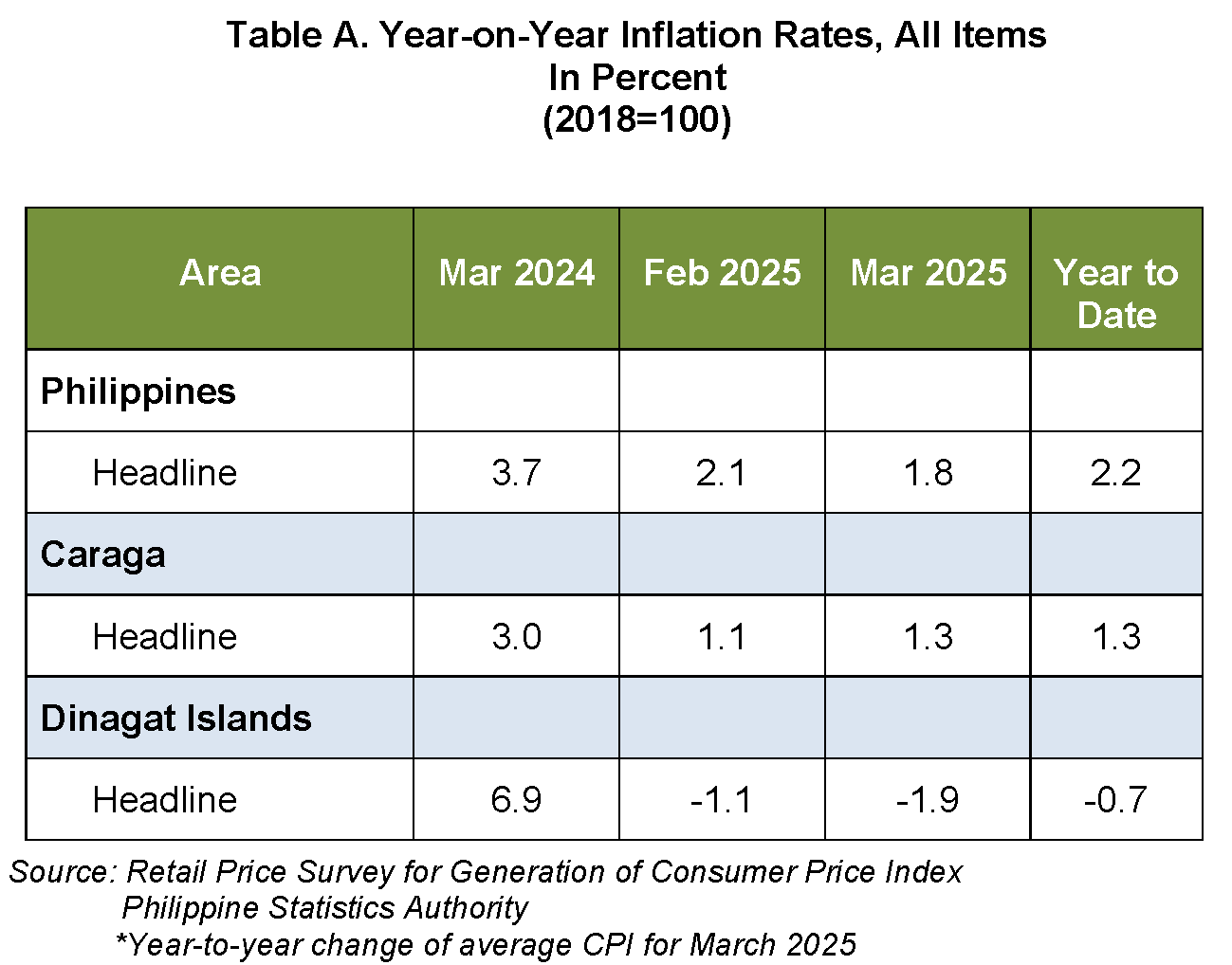

Headline Inflation
The headline inflation rate in the Province of Dinagat Islands decreased to -1.9 percent in March 2025, a reduction from -1.1percent in February 2025. This points a 0.8 percentage drop from the previous month and an important 8.8 percentage point decrease compared to March 2024. The year-to-date average inflation rate stands at -0.7 percent, significantly below the national average (2.2 percent) and the Caraga regional average (1.3 percent). Table A and Figure 1.
Key Drivers to the Continued Decline
The continued decline in March 2025 was primarily driven by the faster drop in the average retail prices of Food and Non-Alcoholic Beverages group, which recorded a -4.0 percent inflation rate and contributed 94.1 percent to the overall decline in provincial inflation.
Other contributing commodity groups to the deceleration of inflation rate for March 2025 include:
• Alcoholic Beverages and Tobacco: Inflation eased to 4.3 percent, contributing 1.7 percent to the decline.
• Furnishings, Household Equipment & Routine Maintenance: Lower inflation of 2.2 percent, accounting for a 1.6 percent drop.
Moreover, the following commodity groups were also noted to have declining inflation rates this March 2025:
1. Information and Communication: Dropped to 0.9 percent from 1.4 percent in February.
2. Health: Declined further to -1.4 percent from -1.1 percent.
3. Personal Care & Miscellaneous Goods and Services: Eased to 0.8 percent from 0.9 percent.
Despite the overall decline of the inflation rate in March 2025, some commodity groups registered higher inflation for the month of March 2025:
1. Clothing and Footwear: Rose to 1.5 percent from 0.4 percent.
2. Housing, Water, Electricity, Gas & Other Fuels: Increased to 1.2 percent from 0.5 percent.
3. Transport: Slight improvement, from -2.7 percent to -2.6 percent.
4. Recreation, Sports, and Culture: Rose to 2.7 percent from 2.6 percent.
5. Restaurants and Accommodation Services: Increased to 1.5 percent from 1.0 percent.
On the other hand, these were the commodity groups showing a stable inflation rate. Inflation in the following groups remained unchanged:
1. Education Services: 0.0%
2. Financial Services: 0.0%
Top Contributors to the Overall Provincial Inflation Rate of -1.9 percent
The overall inflation rate of -1.9 percent in the Province of Dinagat Islands for March 2025 is the result of weighted contributions from various commodity groups. These groups pushed the inflation rate lower or maintained its negative level, reflecting the relative price changes and consumption patterns across households.
1. Food and Non-Alcoholic Beverages: This group contributes 117.7 percent or -2.24 percentage points to the overall inflation rate which can be pointed out directly to cereals which recorded a drop in the inflation rate from 14.1 percent in February 2025 to 20.2 percent in March 2025.
2. Transport: It contributes about 11.5 percent or -0.22 percentage points, to the total provincial inflation rate. Lower retail prices of gasoline for this month recorded an inflation rate of -5.5 percent from -4.2 percent in previous month.
3. Health: With a contribution of 2.5 percent or -0.05 percentage points, the health sector also supported the overall inflation reduction. Decreased prices for vitamins and minerals resulted to an inflation of -3.8 percent this March from -3.4 percent in February 2025.
Food Index
The food index for province continued its downward trend in March 2025, posting an evident decline at -5.0 percent, compared to -3.0 percent in February 2025. Several key food subgroups contributed to this intense deflation:
1. Cereals and Cereal Products (ND): This subgroup experienced the most significant price drop, with inflation plummeting to -16.9 percent in March from -11.5 percent the previous month. This decline accounted for a 82.9 percent of the total decrease in food inflation. This can be due to the speedy drop in the average retail prices for Rice recording an inflation rate of -20.6 percent from -14.4 percent in previous month.
2. Vegetables, Tubers, Plantains, Cooking Bananas, and Pulses: Prices in this group toned-down as well, with inflation decreasing to 5.0 percent from 8.4 percent in February. This contributed to 8.8 percent to the overall decline in food inflation. Particularly, the slower increase in the average retail prices of fruit-bearing vegetables like tomatoes with an inflation rate of -16.7 percent from 18.1 percent in February. Moreover contributing also is the faster drop in the average retail prices for sweet potatoes with inflation rate of -5.9 percent from 7.8 percent in previous month.
3. Milk, Dairy Products, and Eggs (ND): Inflation fell slightly to 3.4 percent, down from 4.4 percent in the previous month. The slower price increase of the average retail price for eggs from 6.6 percent in February to 5.3 percent this month helped reduce overall food inflation thus contributing 2.7 percent to the total decline.
Purchasing Power of the Peso
The Purchasing Power of the Peso (PPP) in Dinagat Islands held steady at Php 0.73 in March 2025, reflecting consistent value since December 2024.
(Sgd.) GLENNBOY C. LISTON
Chief Statistical Specialist
Dinagat Islands-PO

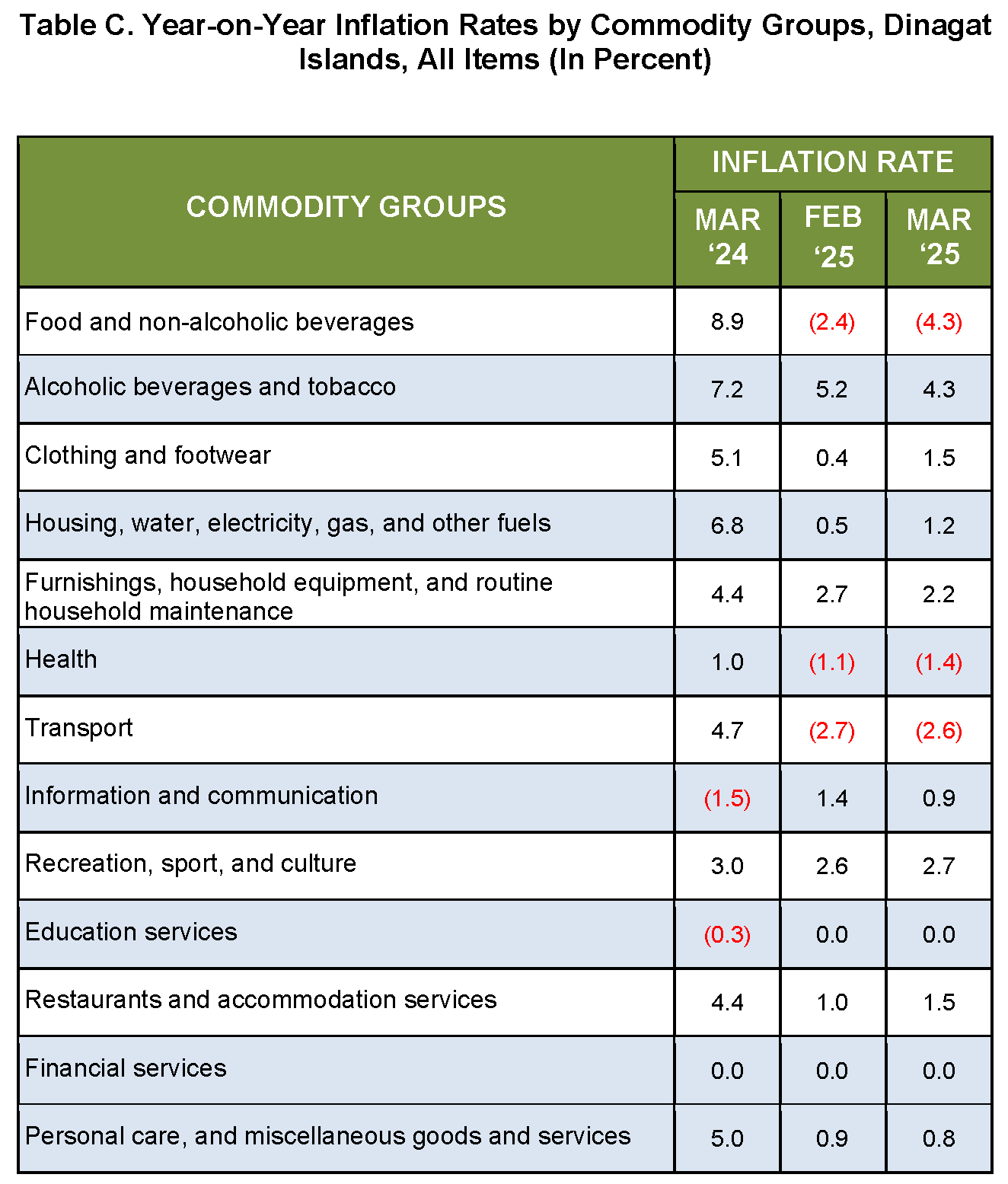
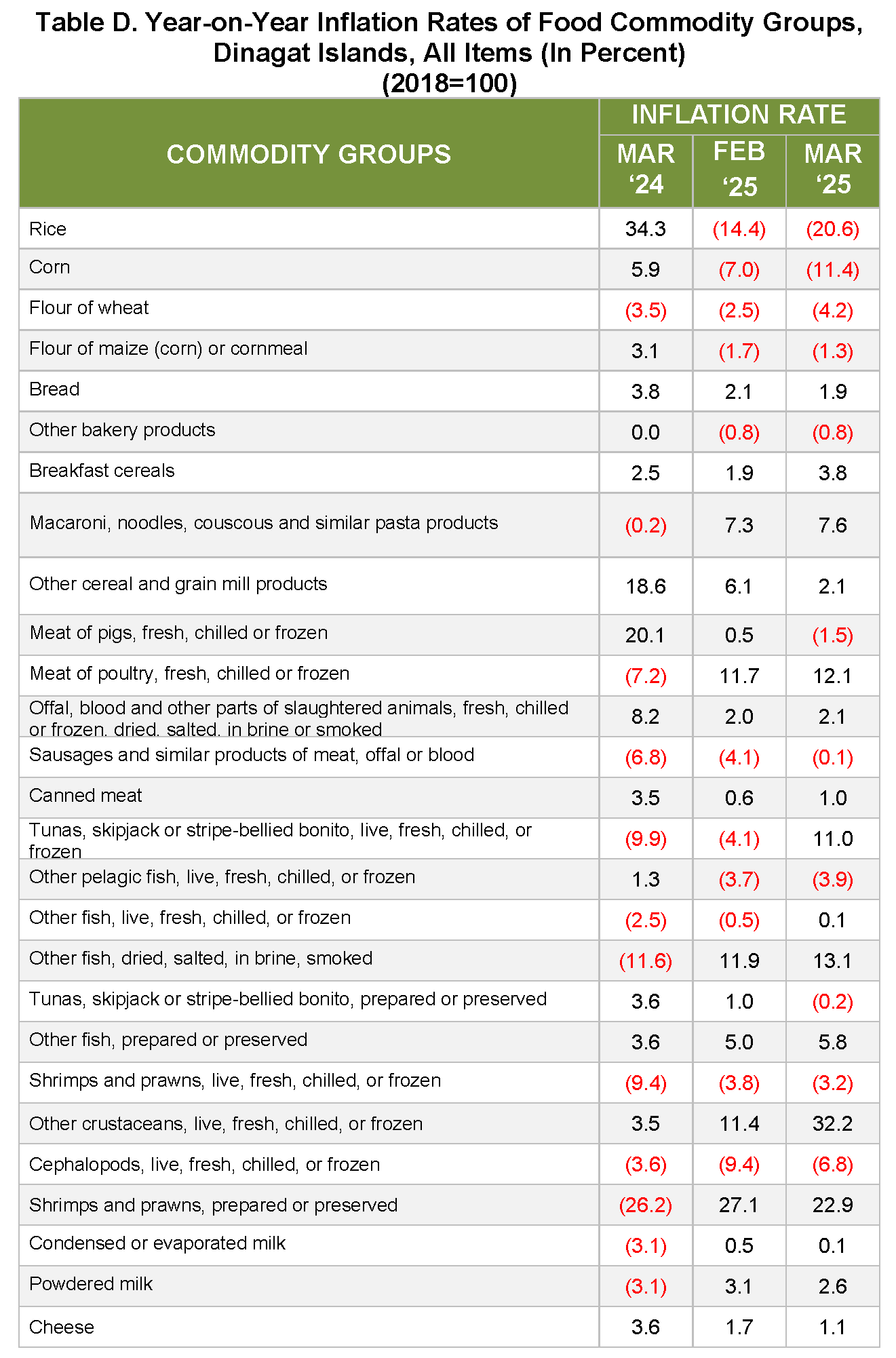
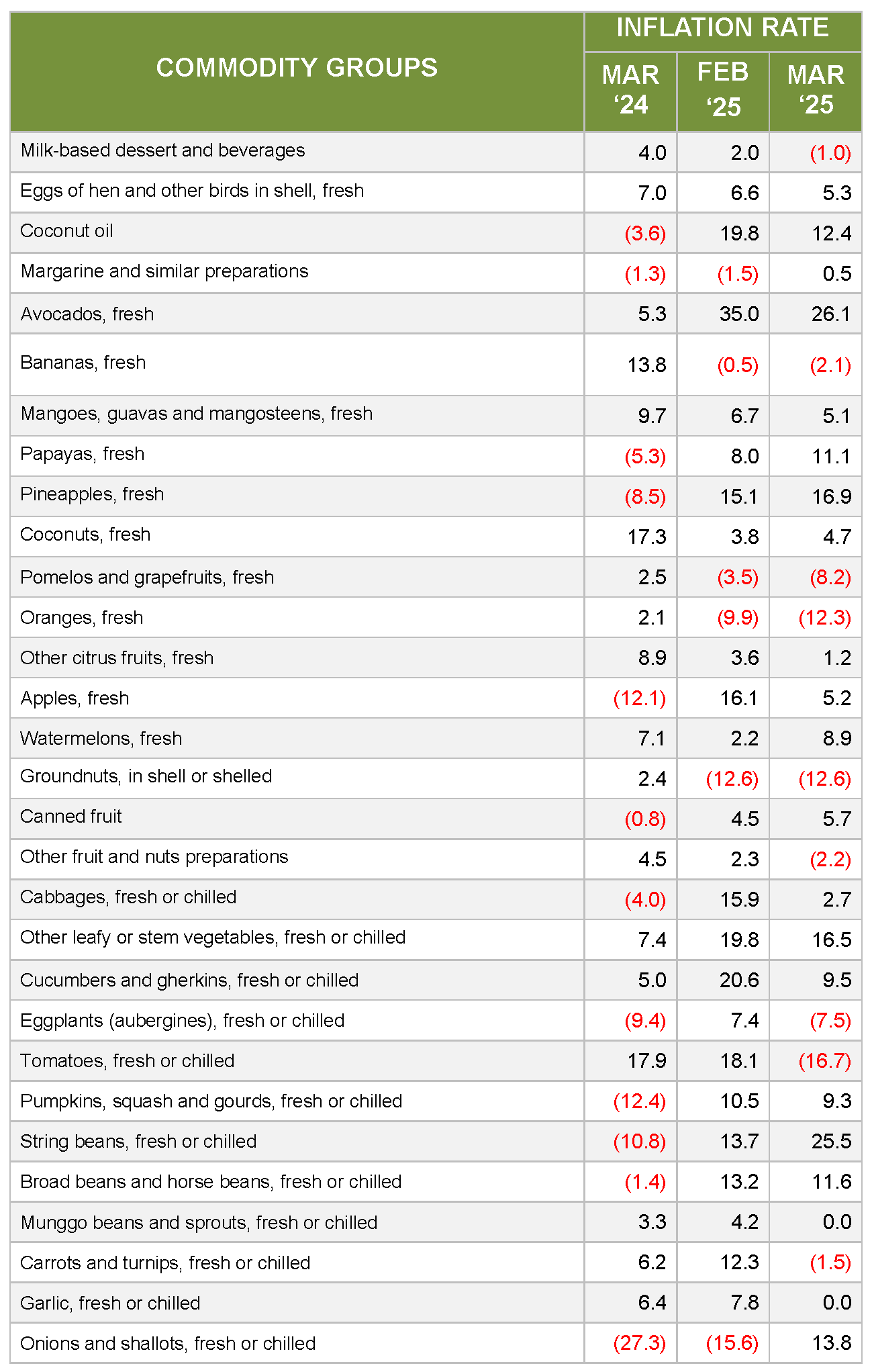
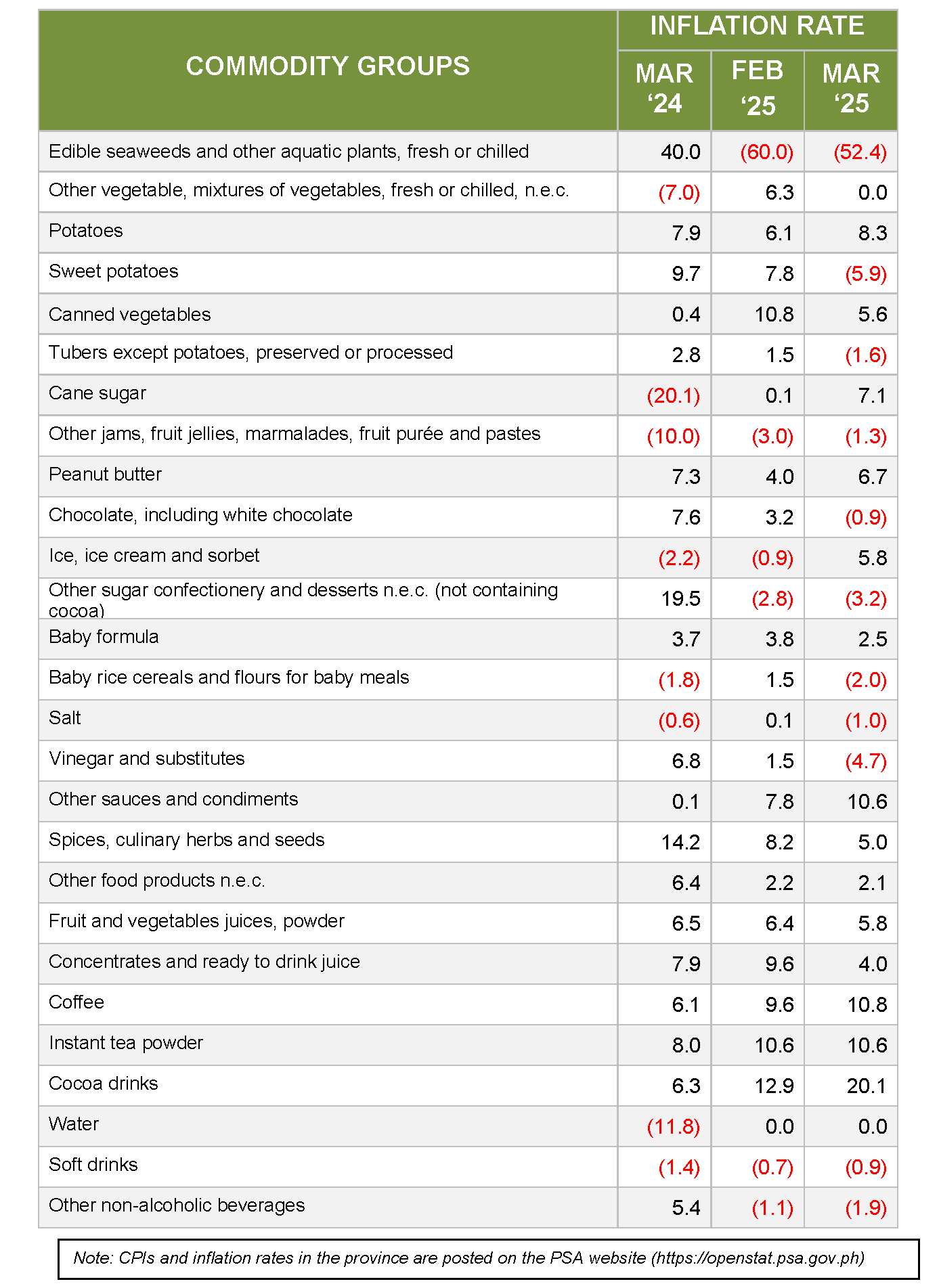
Technical Notes
The Philippine Statistics Authority generates the monthly Consumer Price Index (CPI) based on the nationwide survey of prices for a given basket of goods and services. Two important indicators, the inflation rate and purchasing power of the peso (PPP) are derived from the CPI which is important in monitoring price stability and the value of the country’s currency.
The Consumer Price Index (CPI) is an indicator of the change in the average retail prices of a fixed basket of goods and services commonly purchased by households relative to a base year. It shows how much on the average, prices of goods and services have increased or decreased from a particular reference period known as base year.
The CPI is mostly used in the calculation of the rate and purchasing power of the peso. It is a major statistical series used for economic analysis and as monitoring indicator of government economic policy.
The CPI is also used to adjust other economic series for price changes. Another major importance of the CPI is its use as basis to adjust wages in labor management contracts as well as pensions and retirement benefits.
Inflation rate refers to the rate of change in the average prices of goods and services typically purchased by consumers. It is interpreted in terms of declining purchasing power of money.
The Purchasing Power of the Peso (PPP) indicates the value of the peso in the period under review as compared to the value of the peso in the base period. It is computed as the reciprocal of the CPI for the period under review multiplied by 100.

